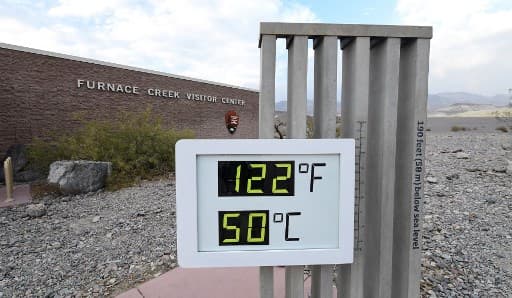
(AFP) — The western United States and Canada faced scorching temperatures to start the week, with heat warnings still in place Monday and authorities struggling to bring wildfires under control in both countries.
Sweltering conditions hit much of the Pacific seaboard and as far inland as the western edge of the Rocky Mountains on Saturday and Sunday.
The US National Weather Service (NWS) had warned of a dangerous heatwave and said temperature records would likely be broken over the weekend, forecasting highs of 125-130 degrees Fahrenheit (52-54 Celsius) in California’s Death Valley, often the hottest place in the country.
The NWS said temperatures would dip slightly from Monday, but added: “This small relative cool down is of little relief to areas that have seen long-term oppressive and above normal temperatures.
“Excessive heat warnings remain in effect for a majority of locations in the region through Tuesday.”
Canadian meteorologists predicted highs approaching 90 Fahrenheit (32 Celsius) would continue in parts of western Canada on Monday — well above seasonal norms.
– Wildfires raging –
A fire in northern California continued to grow overnight Sunday, spurred by the heat and increased winds.
Authorities said they had received reports of homes destroyed in multiple towns and urged residents to stay away, with footage from the area showing burnt-out abandoned cars and houses.
Large areas of forest in Beckwourth appeared to be on fire, with huge clouds of smoke rising above the hills.
In the state of Oregon, the Bootleg Fire more than tripled in size between Friday and Sunday, gaining more than 100,000 acres, according to the US Forest Service.
In Canada, more than 50 new wildfires have erupted in the past two days.
Canadian transport minister Omar Alghabra on Sunday announced new emergency measures aimed at preventing further wildfires in the tinder-dry region, including steps to slow or limit train traffic.
Trains are a common cause of wildfires, often when their spark-arresting devices are poorly maintained.
Several roads and highways in the area have been closed as the government rated the wildfire risk in much of the province as “extreme.”
A dozen towns or locales remained under evacuation orders.
The Canadian government has sent investigators to the town of Lytton, 150 miles (250 kilometers) northeast of Vancouver, to see whether a passing cargo train might have caused a late June fire that destroyed 90 percent of the town.
As of Sunday night, the number of wildfires across the province of British Columbia was continuing to rise, hitting over 300, authorities said.
– Climate change –
The weekend’s hot weather follows an earlier heatwave that struck the same regions at the end of June.
A study by a group of leading climate scientists found that those conditions would have been “virtually impossible” without human-caused climate change.
The World Weather Attribution group said that global warming, caused by greenhouse gas emissions, made the June heatwave at least 150 times more likely to happen.
The scorching conditions saw the all-time record daily temperature broken three days in a row in British Columbia.
Last month was the hottest June on record in North America, according to data released by the European Union’s climate monitoring service.
Human activity has driven global temperatures up, stoking increasingly fierce storms, extreme heatwaves, droughts and wildfires.
The World Meteorological Organization and Britain’s Met Office said in May there was a 40 percent chance of the annual average global temperature temporarily surpassing 1.5 degrees above pre-industrial temperatures within the next five years.
The past six years, including 2020, have been the six warmest on record.
© Agence France-Presse
